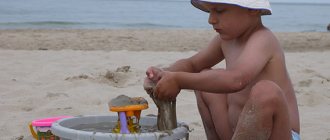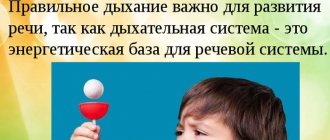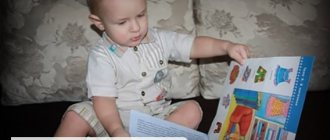Speech therapy classes
— a section with notes on group, frontal, individual speech therapy and logorhythmic classes, as well as integrated classes, master classes on non-traditional teaching methods. We are confident that the materials posted here will be interesting and informative not only for specialists in children's educational institutions, but also for parents who show a sincere interest in the development of their child.
Experienced specialists share their knowledge here, and for beginning speech therapists, the presented notes will help them plan their classes correctly and in a fun way.
Speech characteristics of children 4-5 years old
At this age, children begin to actively expand their vocabulary. So, by the age of 5, on average, a child already has about three thousand words in stock. In addition, five-year students begin to create more complex sentence structures. If previously they consisted of a maximum of 3-4 words, then at this age one sentence can consist of up to 10 words.
Speech therapy classes for children 4-5 years old are very important
Sentences produced by a child aged 4-5 years are not always logically constructed correctly. If a child is telling a long story or retelling a fairy tale, he does not need to be corrected if the main idea or logic is lost. For this age this is within the normal range.
Note! Also, at the age of five, children often not only tell what they saw or heard, but also make up stories themselves, without relying on their life experience. This only once again confirms the correctness of development. Ridiculous stories are one of its components.
Basic characteristics of a child’s speech at 4-5 years old
By the age of five, a child already begins to distinguish sounds and is able to determine the presence or absence of a particular sound in a certain word. Normally, during the period of 4-5 years, a child should already have completed the formation of the pronunciation of certain sounds and letters that were previously difficult to achieve. So, for example, at 4 years old all hissing sounds should already be present in speech. And by the age of 5, a child should master such complex sounds as “l” and “r”.
In practice, everything is not always so perfect and more than half of children have some speech deviations. The following speech underdevelopment occurs:
- phonetic;
- phonetic-phonemic;
- general.
Important! Simply put, children do not recognize, discriminate, or have serious difficulty pronouncing sounds.
Speech problems in children
Speech disorders in children can be caused by the following reasons.
Phonetic underdevelopment
Perhaps the most common type of violation is the incorrect pronunciation of one or more sounds. Before a speech therapist, you can visit an orthodontist - sometimes the problem can be solved by cutting the frenulum.
Phonetic-phonemic underdevelopment
With such a violation, the baby cannot even hear the sound correctly. Difficulties arise with speech, writing, and learning languages. Ask your child to repeat after you the chains of words: “dom-som-kom-lom” or syllables: “gu-ku-gu-ku.” If he makes a mistake, this is a warning sign.
General underdevelopment
Poor vocabulary, difficulty expressing thoughts, inability to write a description of a picture... As a rule, such children begin to speak later than their peers. They find it difficult to concentrate and remember. In addition to a speech therapist, you will most likely need a neurologist.
Pathologies associated with injuries, heart defects, damage to the nervous system
Examples of such pathologies include alalia, aphasia and dysarthria.
Alalia occurs due to damage to the nervous system. The child speaks very poorly, and his speech is meaningless, or he does not speak at all. Also, sometimes a baby may suffer from movement disorders, hyperactivity, or, conversely, retardation.
If alalia implies that speech initially develops incorrectly or does not develop, then aphasia is an acquired disorder. It can be caused by damage to the cerebral cortex, head injuries, and heart defects. With aphasia, children do not understand other people's speech and do not control their own, do not remember words well, and change sounds and syllables.
Dysarthria is a relatively rare disorder in which a person's speech is slurred and slurred. Dysarthria is provoked by disturbances in speech breathing and articulation, which are associated with lesions of the nervous system.
Such problems need to be dealt with comprehensively - with the help of neurologists, teachers, psychologists and speech therapists.
How to conduct classes at home correctly
It is not necessary to immediately run to a speech therapist. To begin with, you can try exercises for speech therapy classes for children 4-5 years old at home. They will help the child master correct speech, learn to hear and pronounce missing sounds.
Children should definitely be taught at home so that they learn how to pronounce sounds correctly.
Typically, speech therapists advise following these simple rules:
- Exercises should be performed every day, always in a child-friendly environment.
- Be sure to conduct lessons in a playful way. It is important to captivate the child so that the tasks do not seem boring and uninteresting to him. You can even arrange a sort of competition to see who can complete the tasks better or faster.
- You cannot criticize or make sarcastic remarks to your child. So the desire to learn something new will disappear completely. Be sure to praise your child when he completes a task. Even if something doesn’t work out, you need to praise him for trying.
- For classes, be sure to use literature that is designed to help parents teach their children independently. There are special reference books on speech therapy, which contain many different exercises for children, as well as recommendations for parents.
- A speech therapy exercise for children 4-5 years old can be turned into pleasure if you correct your speech by studying rhymes and tongue twisters. They will not only allow the child to quickly grasp the necessary sounds, but will also have a positive effect on the development of memory.
- You need to show your child an example of correct speech. Pronounce all words clearly so that the baby understands and clearly hears what is being said to him. You need to talk to him as much as possible, have conversations on any topic, tell different stories.
Complex of articulatory gymnastics for children 2-3 years old
High-quality warm-up for lips and tongue
Warming up the lips and tongue plays an important role in the formation of correct speech.
Note! The baby will begin to pronounce words more clearly, without swallowing the ending.
Exercises as a warm-up:
- Stretch your lips in a smile without showing your teeth. You should try to smile as widely as possible.
- Pull your lips forward as if they were an elephant’s proboscis.
- Take turns inflating one or the other cheek, then retract them in the same order.
- Open your mouth and pull your lower jaw as low as possible, while holding your tongue to the roof of your mouth.
- Open your mouth, stick out your tongue. Then put it in your mouth. Do this exercise for 15 seconds.
- Pull out your tongue and blow on a piece of cotton wool on the table until it falls off the table. Blowing with lips is prohibited.
- Use the tip of your tongue to first move along the upper teeth from the inside, then along the lower ones.
- “Scratch” your tongue with your teeth, resting on the lower gum.
Important! To achieve visible results, you need to perform these exercises regularly. Each of them must be repeated at least 5-6 times.
Developing general imitation
In the earliest stages of growth, children can play games aimed at reproduction. This is copying the movements of an adult, which help to relax. The tasks train coordination and imagination. Today the little one repeats gestures, and tomorrow - words. Yes, do not forget to accompany such gestures with conversations. When you have a child with general speech underdevelopment (GSD), carrying out activities of this kind is the basis of speech therapy.
The simplest thing we can offer is regular charging. Activity lovers will appreciate this. Just do the gymnastics in a strictly defined sequence. The goal here is for a tiny person to memorize the whole combination. Be sure to comment every time. Children love repetitions. And if you touch on in-depth material, you can use the following fun.
Exercises for general speech development at home
At home, it is imperative to regularly conduct speech therapy classes for children 4-5 years old, the exercises of which include not only the speech part, but also gymnastics for the speech organs and fingers.
Finger gymnastics
This set of simple exercises stimulates the part in the brain center that is responsible for correct speech. This is why fine motor skills classes are needed not only for the little ones, but also for preschoolers.
Finger exercises stimulate the part of the brain responsible for correct speech
All exercises are done 8-10 repetitions:
- “Opening” and “closing” the fingers on each hand. First one by one, then together. You can gradually increase the speed.
- Place your hands on the table: the left one touches the table with the palm, the right one with the back. Then at the same time you need to turn your hands over.
- First, draw a river: fold your hands, palms up, as if you have water in them. Then depict a steamboat - put your palms together, press your thumbs together and lift them up. Then depict the fish that have arrived: press all your fingers together, palms together and make movements with your hands, as if a fish is swimming.
- Draw a tree with branches - arms vertically, fingers spread out in different directions. Then show the roots of the tree - in the same position, move your hands with your fingers down. Then show leaf fall: quickly, quickly clench and unclench your fingers.
Articulation gymnastics
These exercises are aimed at developing the tongue, the main organ responsible for the correct pronunciation of sounds.
Innovative technologies in speech therapy: laptop and speech therapy corner
Note! Thanks to regular training in articulation gymnastics, the child will soon begin to pronounce even the most difficult sounds.
- Smile as wide as possible, teeth are closed, exactly on top of each other. Stay in this position and count 10 seconds.
- Pull your lips forward and pretend as if an elephant is drawing water with its trunk. Stay for 10 seconds in this position.
- Pretend to be a snake: smile broadly, stick out your tongue like a tube, then hide it back.
- Open your mouth wide and make a clicking sound with your tongue, imitating a horse. At the same time, it is important to ensure that the child’s lower jaw is motionless and only the tongue is working.
- Smile widely, stick out your tongue as far as possible and lightly squeeze it between your teeth. In this position, “pull” the tongue back into the mouth.
- Open your mouth wide, stick out your tongue and pretend to be a clock - move your tongue from one corner of your mouth to the other.
Repeat all these exercises 8-10 times or for 10-15 seconds.
Games for developing phonemic sound
Speech therapy games for 4-5 year old children to develop phonemic sound must be included in daily classes. They are simple and at the same time interesting, and the results will not take long to arrive. After just a month of regular exercises, the quality of children's speech will noticeably improve.
- "Game of Silence" This game is very simple. The child is asked not to make a sound for 2 minutes and close his eyes. As soon as the time is up, then ask the baby to tell what sounds he heard.
- "Clap-stomp." The essence of the game: agree in advance with the child which sound he will stomp on and which sound he will clap on. For example, if he hears the sound [w], then he stomps his foot, if the sound [r], then he claps his palms. Next, the adult names different sounds, and when the child hears the ones he needs, he claps or stomps.
- "Catch the word." The essence of this game is simple: the child is given a word, upon hearing which he will have to clap his hands. Next, the adult names several words in turn that sound similar. As soon as the child hears what he needs, he should clap his hands.
To develop phonemic sound, it is necessary to regularly play speech therapy games
Complex No. 3
“This is our tongue.”
- In the sea there is a fish - a whale lives,
She floats on the waves
She has a huge mouth. Here it is!
(Smile widely, showing your teeth, your teeth are also slightly open, hold your mouth in this position for a while)
- A moth lives in a field,
He drinks flower nectar
Thin, long proboscis. Like this!
(Stretch your lips forward with a narrow tube, “admire” the proboscis)
- A snake lives under a tree stump,
Long tail and head
He takes it out, hides the tongue... That's it!
(the mouth is open with a round window, the sharp tongue is shown and hidden)
- The bunny lives in the grove,
He gnaws the grass and branches,
He wrinkles his nose funny.
Happened? That's it, here!
(wrinkle nose, lifting upper lip, showing upper teeth,
but the teeth are closed)
- Our Sharik lives in the booth,
He guards the house diligently,
He wags his tail cheerfully.
How? Let's show it with our tongue! Look!
(the mouth smiles, the teeth are slightly open, the sharp narrow tongue quickly moves left and right)
Features of practicing hissing sounds
To teach a child to correctly pronounce hissing sounds, you must first introduce whistling sounds. If a child in the fourth year of life has learned to pronounce whistling sounds, then there should be no problems with hissing sounds. You can install them with a few simple exercises.
- "Naughty tongue." The child sticks the tip of his tongue out of his mouth. Then he lightly slaps it with his fingers, while saying: “five-five-five.”
- "Delicious jam." The lower lip is pulled down so that the teeth are visible. And the tip of the tongue licks the upper lip, as if it is very sweet there. At the same time, the lower jaw should remain motionless during the exercise.
- “Hide the candy.” Mouth closed. Tighten your tongue and touch your left, then your right cheek. It's like there's candy hiding behind your cheek.
Repeat exercises at least 5 times.
Note! Producing the sounds of native speech is very important for children. It will help them not only make contact with their peers, but also better master the preschool and school curriculum. Parents have the power to help their children avoid difficulties in the future and put the sounds correctly in time.
The role of the book
The book serves as an integral attribute in the formation of sound pronunciation. Judge for yourself, the plot, illustrations, and new characters are of interest. Perfectly suitable for use even with varying degrees of severity of OHP. The simplest texts of folk tales are aimed at helping the little one.
Sukhomlinsky also noted:
“Reading books is the path along which a skillful, intelligent, thinking teacher finds the way to a child’s heart.”
You talk, show pictures at the same time, discuss the plot. Start reading when your heir is not talking yet. Believe me, the vocabulary is already being formed. Just read with intonation so that the tomboy wants to reproduce it. Use the easiest nursery rhymes in the initial stages.
Include imitation here. You can assign roles once the script is memorized. Copy a clumsy bear, a bunny, a fox, and the baby will happily copy! Answer questions. Only when the little sly one is already able to pronounce words out loud, but uses gestures to ask for something, do not indulge.
My daughter was one of the first to master the “give” request, before she was a year old. But when I realized that I would still get the item I was interested in, I excluded it from my vocabulary. Don't be lazy! But you can’t demand either. It is important to generate interest.
Variety of forms and games
To prevent a preschooler from getting bored of repeating the same thing several times, you should think through an unusual game scenario and give him different tasks:
- not just pronounce words, but make rhythmic movements with your feet or hands in time with them;
- “teach” the toy a simple phrase or rhyme, show how to pronounce the text correctly;
- pronounce the text, imagining yourself as a fox or a bunny, make appropriate facial expressions and gestures.
You can make a speech therapy session even more exciting if you dress the baby in the costume of the animal being depicted.
Rhymes and sayings can not only be pronounced, but also sung, coming up with a suitable motive for them.
You can stimulate the development of fine motor skills, which are directly related to the speech center, by performing finger gymnastics - putting special dolls on your fingers, creating dramatizations, while simultaneously pronouncing poems and phrases with the sound being practiced. For example, when working on the phoneme [p], you can offer a preschooler a pig finger puppet and ask him to grunt.
To prevent your child from getting tired, every 5-10 minutes of class you should take a break and do breathing exercises. For example, “Dandelion” - take a deep breath through your nose, as if inhaling the aroma of flowers, and then exhale through your mouth, as if blowing on a fluffy dandelion.
Contents of correctional work
A speech therapist works with children aged 3-4 years in the following areas:
- sound pronunciation correction;
- development of the impressive and expressive sides of speech;
- development of the motor sphere;
- development of the psychological basis of speech.
Correction of sound pronunciation consists of several stages - preparatory (formation of the articulatory base), production, automation (consolidation of correct pronunciation) and differentiation (if the child confuses sounds in speech). Sound automation is carried out in the following order:
- in syllables - pronouncing syllabic paths, pure phrases;
- in words;
- in phrases and sentences - tongue twisters, pronouncing and memorizing couplets;
- in independent coherent speech.
In parallel with the correction of the sound-pronunciation aspect of speech, work is being carried out in the above areas. When working with the motor area, the speech therapist offers the following tasks:
- on coordination of movements, the ability to navigate in space;
- finger gymnastics;
- working with lacing, assembling mosaics;
- articulatory gymnastics.
Working with the impressive side of speech includes the following tasks:
- accumulation of vocabulary, assimilation of new words denoting the names of body parts, objects surrounding the child, signs, verbs denoting everyday and play actions;
- learning to understand general words;
- clarifying the understanding and use of personal and possessive pronouns and adjectives.
In working to correct the expressive side of speech, the speech therapist is engaged in clarifying and activating the passive vocabulary on certain lexical topics. Adjectives and personal pronouns are introduced into children's speech. The baby is taught to compare objects, find the same characteristics and differences.
During correctional classes, work is carried out on the formation of grammatical structure of speech:
- the ability to coordinate words in phrases and sentences;
- changing words by numbers;
- developing the ability to use possessive adjectives;
- developing the ability to form diminutive forms of words.
Fun workout
Outdoor games strengthen the muscles of the child’s body, prevent flat feet, develop coordination of movement, and contribute to the development of motor skills and speech.
Types of outdoor games:
- different types of walking (side step, walking on heels, toes);
- climbing, overcoming obstacles;
- ball games;
- balance exercises (sliding down a hill, walking on an inclined bench).
Diagnostic approach
During a speech therapy examination of younger preschoolers, the specialist uses visual material (pictures, toys) and didactic games. Speech material for diagnosis is selected according to age. Instructions should be simple and understandable and not contain overly complex structures.
The speech therapist, if possible, conducts a conversation with the parents in order to more accurately establish the cause of the speech disorder. Diagnostics are carried out in the following areas:
- examination of the state of the motor sphere (general, finger, articulatory motor skills);
- force and duration of exhalation;
- sound pronunciation (checking sound in isolation, in syllables, words);
- phonetic-phonemic processes (discrimination of sounds in the speech stream, sound-letter analysis skills);
- syllable structure;
- impressive and expressive vocabulary;
- grammatical structure of speech (the ability to coordinate words in phrases and sentences, inflection and word formation skills);
- formation of independent coherent speech.
The speech therapist pays attention to the child’s understanding and compliance with instructions; how detailed he answers; completes sentences with prepositions, conjunctions and pronouns. They offer to tell you what is shown in the picture, about your family, favorite toy, etc.
d.
Up to 3 years of age, a speech therapist diagnoses speech development delay - delayed speech development, and after that - one of the above-mentioned speech disorders. This is due to the fact that the child intensively masters the language.









